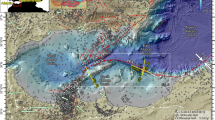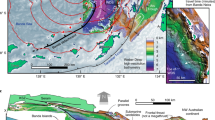Abstract
The Arabia–India plate boundary—also called the Owen fracture zone—is perhaps the least-known boundary among large tectonic plates1,2,3,4,5,6. Although it was identified early on as an example of a transform fault converting the divergent motion along the Carlsberg Ridge to convergent motion in the Himalayas7, its structure and rate of motion remains poorly constrained. Here we present the first direct evidence for active dextral strike-slip motion along this fault, based on seafloor multibeam mapping of the Arabia–India–Somalia triple junction in the northwest Indian Ocean. There is evidence for ∼12 km of apparent strike-slip motion along the mapped segment of the Owen fracture zone, which is terminated to the south by a 50-km-wide pull-apart basin bounded by active faults. By evaluating these new constraints within the context of geodetic models of global plate motions, we determine a robust angular velocity for the Arabian plate relative to the Indian plate that predicts 2–4 mm yr−1 dextral motion along the Owen fracture zone. This transform fault was probably initiated around 8 million years ago in response to a regional reorganization of plate velocities and directions8,9,10,11, which induced a change in configuration of the triple junction. Infrequent earthquakes of magnitude 7 and greater may occur along the Arabia–India plate boundary, unless deformation is in the form of aseismic creep.
This is a preview of subscription content, access via your institution
Access options
Subscribe to this journal
Receive 12 print issues and online access
$259.00 per year
only $21.58 per issue
Buy this article
- Purchase on Springer Link
- Instant access to full article PDF
Prices may be subject to local taxes which are calculated during checkout



Similar content being viewed by others
References
Matthews, D. H. The Owen fracture zone and the northern end of the Carlsberg Ridge. Phil. Trans. R. Soc. A 259, 172–186 (1966).
Whitmarsh, R. B. The Owen basin off the south-east margin of Arabia and the evolution of the Owen fracture zone. Geophys. J. R. Astron. Soc. 58, 441–470 (1979).
Quittmeyer, R. C. & Kafka, A. L. Constraints on plate motions in southern Pakistan and the northern Arabian Sea from the focal mechanisms of small earthquakes. J. Geophys. Res. 89, 2444–2458 (1984).
Gordon, R. G. & DeMets, C. Present-day motion along the Owen fracture zone and Dalrymple trough in the Arabian Sea. J. Geophys. Res. 94, 5560–5570 (1989).
DeMets, C., Gordon, R. G., Argus, D. F. & Stein, S. Current plate motions. Geophys. J. Int. 101, 425–478 (1990).
DeMets, C., Gordon, R. G., Argus, D. F. & Stein, S. Effect of recent revisions of the geomagnetic reversal time scale on estimates of current plate motions. Geophys. Res. Lett. 21, 2191–2194 (1994).
Wilson, T. J. A new class of faults and their bearing on continental drift. Nature 207, 343–347 (1965).
Merkouriev, S. & DeMets, C. Constraints on Indian plate motion since 20 Ma from dense Russian magnetic data: Implications for Indian plate dynamics. Geochem. Geophys. Geosyst. 7, Q02002 (2006).
Cochran, J. R. Himalayan uplift, sea level, and the record of Bengal Fan sedimentation at the ODP LEG 116 Sites. Proc. Ocean Drill. Program, Sci. Results 116, 397–414 (1990).
Harrison, T. M., Copeland, P., Kidd, W. S. F. & Yin, A. Raising Tibet. Science 255, 1663–1670 (1992).
Molnar, P., England, P. & Martinod, J. Mantle dynamics, uplift of the Tibetan plateau, and the Indian monsoon. Rev. Geophys. 31, 357–396 (1993).
Whitmarsh, R. B. et al. Initial report DSDP, US Government Printing Office, Washington, D.C., v. 23, p. 1180 (1974).
Fournier, M., Patriat, P. & Leroy, S. Reappraisal of the Arabia–India–Somalia triple junction kinematics. Earth Planet. Sci. Lett. 189, 103–114 (2001).
Sella, G. F., Dixon, T. H. & Mao, A. L. REVEL: A model for recent plate velocities from space geodesy. J. Geophys. Res. 107, 2081 (2002).
Kreemer, C., Holt, W. E. & Haines, A. J. An integrated global model of present-day plate motions and plate boundary deformation. Geophys. J. Int. 154, 8–34 (2003).
Nocquet, J.-M., Willis, P. & Garcia, S. Plate kinematics of Nubia–Somalia using a combined DORIS and GPS solution. J. Geodesy 80, 591–607 (2006).
Reilinger, R. et al. GPS constraints on continental deformation in the Africa–Arabia–Eurasia continental collision zone and implications for the dynamics of plate interactions. J. Geophys. Res. 111, B05411 (2006).
Vigny, C., Huchon, P., Ruegg, J. C., Khanbari, K. & Asfaw, L. M. Confirmation of Arabia plate slow motion by new GPS data in Yemen. J. Geophys. Res. 111, B02402 (2006).
Minster, J. B. & Jordan, T. H. Present-day plate motions. J. Geophys. Res. 83, 5331–5354 (1978).
Engdahl, E. R., van der Hilst, R. & Buland, R. Global teleseismic earthquake relocation with improved travel times and procedures for depth determination. Bull. Seismol. Soc. Am. 88, 722–743 (1998).
McClusky, S. et al. Global positioning system constraints on plate kinematics and dynamics in the eastern Mediterranean and Caucasus. J. Geophys. Res. 105, 5695–5720 (2000).
Paul, J. et al. The motion and active deformation of India. Geophys. Res. Lett. 28, 647–650 (2001).
Socquet, A. et al. India and Sunda plates motion and deformation along their boundary in Myanmar determined by GPS. J. Geophys. Res. 111, B05406 (2006).
d’Acremont, E. et al. Structure and evolution of the eastern Gulf of Aden: Insights from magnetic and gravity data (Encens Sheba Cruise). Geophys. J. Int. 165, 786–803 (2006).
Newman, A. V. et al. Slow deformation and lower seismic hazard at the new Madrid seismic zone. Science 284, 619–621 (1999).
Engdahl, E. R. & Villaseñor, A. in International Handbook of Earthquake and Engineering Seismology (eds Lee, W. H. K., Kanamori, H., Jennings, P. C. & Kisslinger, C.) Part A, Ch. 41, 665–690 (Academic, New York, 2002).
Abercrombie, R. E., Antolik, M. & Ekström, G. The June 2000 Mw 7. 9 earthquakes south of Sumatra: Deformation in the India–Australia Plate. J. Geophys. Res. 108, 2018 (2003).
Bohnenstiehl, D. R., Tolstoy, M. & Chapp, E. Breaking into the plate: A 7. 6 Mw fracture-zone earthquake adjacent to the Central Indian Ridge. Geophys. Res. Lett. 31, L02615 (2004).
Delescluse, M. & Chamot-Rooke, N. Instantaneous deformation and kinematics of the India–Australia Plate. Geophys. J. Int. 168, 818–842 (2007).
Sandwell, D. T. & Smith, W. H. F. Marine gravity anomaly from Geosat and ERS-1 satellite altimetry. J. Geophys. Res. 102, 10039–10054 (1997).
Acknowledgements
We thank C. DeMets and R. Reilinger for their reviews. We are grateful to Captain Alain Le Bail, officers and crew members of the BHO Beautemps-Beaupré, and to the French Navy Hydrographer Simon Blin and his hydrographic team of the ‘Mission Océanographique de l’Atlantique’. We acknowledge the support of SHOM and IFREMER for the AOC cruise.
Author information
Authors and Affiliations
Corresponding author
Supplementary information
Supplementary Information
Supplementary figure 1 and supplementary table 1 (PDF 483 kb)
Rights and permissions
About this article
Cite this article
Fournier, M., Chamot-Rooke, N., Petit, C. et al. In situ evidence for dextral active motion at the Arabia–India plate boundary. Nature Geosci 1, 54–58 (2008). https://doi.org/10.1038/ngeo.2007.24
Received:
Accepted:
Published:
Issue Date:
DOI: https://doi.org/10.1038/ngeo.2007.24
This article is cited by
-
Probabilistic Seismic Hazard Assessment for the Arabian Peninsula
Pure and Applied Geophysics (2019)
-
Developing a seismic source model for the Arabian Plate
Arabian Journal of Geosciences (2018)
-
India plate angular velocity and contemporary deformation rates from continuous GPS measurements from 1996 to 2015
Scientific Reports (2017)
-
Identification of new deep sea sinuous channels in the eastern Arabian Sea
SpringerPlus (2016)
-
Coastal boulders as evidences of high-energy marine events from Diu Island, west coast of India: storm or palaeotsunami?
Natural Hazards (2015)




